I’d have to say that about 50% of our boat’s contents are
tools and project supplies. That’s what it looks like when you live on a workaboard boat. So that would leave something like 25% to kids’ toys and all our clothes,
and 25% for food.
tools and project supplies. That’s what it looks like when you live on a workaboard boat. So that would leave something like 25% to kids’ toys and all our clothes,
and 25% for food.
Given that we bounce from island to island, our food
supplies are what I would call normal. I have land friends that have more food
stored away in their pantries than we do. We only have so much space, and the Armageddon is nowhere in sight, so we keep our stocks pretty low key.
supplies are what I would call normal. I have land friends that have more food
stored away in their pantries than we do. We only have so much space, and the Armageddon is nowhere in sight, so we keep our stocks pretty low key.
When we first started out we had no idea what we were doing
and provisioned like if we were headed out to sea, and probably had enough
canned food for a return trip too. Sadly, most of those cans either expired
while sitting at the back of the cupboard, or rusted out and had to get
chucked. Who knows why we thought we would ever eat canned vegetables, or need
that much canned chicken, neither of which we regularly consume. It was a waste
of money and space to have done what we did. We know better now.
and provisioned like if we were headed out to sea, and probably had enough
canned food for a return trip too. Sadly, most of those cans either expired
while sitting at the back of the cupboard, or rusted out and had to get
chucked. Who knows why we thought we would ever eat canned vegetables, or need
that much canned chicken, neither of which we regularly consume. It was a waste
of money and space to have done what we did. We know better now.
We have come to discover that pretty much every island has a grocery
store (sure some only carry certain dried goods, that may or may not already be
expired), but most have a very good selection of food and produce. And you
pretty much always know in advance, thanks to the coconut telegraph (ie other
sailors) what to expect of islands along the way. So you know whether you
should buy a little extra to sustain you until your next decent market.
store (sure some only carry certain dried goods, that may or may not already be
expired), but most have a very good selection of food and produce. And you
pretty much always know in advance, thanks to the coconut telegraph (ie other
sailors) what to expect of islands along the way. So you know whether you
should buy a little extra to sustain you until your next decent market.
Now, if you are thinking with your wallet, you may say, “well
it is cheaper to stock up on canned pasta sauce here”, and it very well may be.
But do the math too, will you be able to eat all of what you purchase before it
expires or the cans rust out? Because if not, then that money is wasted. Or
will weevils be hiding in your stores of dried noodles and have eaten their way
through them before you do? (That was a disgusting discovery of ours, I chucked
it all.)
it is cheaper to stock up on canned pasta sauce here”, and it very well may be.
But do the math too, will you be able to eat all of what you purchase before it
expires or the cans rust out? Because if not, then that money is wasted. Or
will weevils be hiding in your stores of dried noodles and have eaten their way
through them before you do? (That was a disgusting discovery of ours, I chucked
it all.)
We regularly visit land to replenish on fresh vegetables and
fruit, cheese, and eggs. If it weren’t for that, we could probably go about a
couple of weeks with the dry and canned goods we have on board. The Virgin
Islands, where we are now, are very well set up when it comes to grocery
stores. They even have Costco-type stores if there is anything you want to buy
in bulk. So we stock up on certain things just so that we don’t have to do mega
shops every time we go to land. If you were to open our “pantry” right now you
would find lots of Milk (UHT), cereal, flour, pasta sauces, soups, tvp (meat
replacement), and powdered milk (for making yogurt). Our freezer is full of
frozen chicken breasts (we eat a lot of chicken). We buy big amounts of our
favorite and most consumed items, and the other random things can be purchased
on our regular weekly shopping trips.
fruit, cheese, and eggs. If it weren’t for that, we could probably go about a
couple of weeks with the dry and canned goods we have on board. The Virgin
Islands, where we are now, are very well set up when it comes to grocery
stores. They even have Costco-type stores if there is anything you want to buy
in bulk. So we stock up on certain things just so that we don’t have to do mega
shops every time we go to land. If you were to open our “pantry” right now you
would find lots of Milk (UHT), cereal, flour, pasta sauces, soups, tvp (meat
replacement), and powdered milk (for making yogurt). Our freezer is full of
frozen chicken breasts (we eat a lot of chicken). We buy big amounts of our
favorite and most consumed items, and the other random things can be purchased
on our regular weekly shopping trips.
If you are about to head out, and there are islands along
the way, DON’T over think it. Buy what you like (especially if you are picky or
hooked to a name brand) and everything else you can pick up along the way. And
unless you are used to eating things like canned green beans and have a recipe
for them, don’t think that because you are sailing you are going to be forced
to eat them or become the Betty Crocker of the ocean and come up with some
amazing green bean recipe that the whole family will love. You won’t. Leave
that can on the supermarket shelf.
the way, DON’T over think it. Buy what you like (especially if you are picky or
hooked to a name brand) and everything else you can pick up along the way. And
unless you are used to eating things like canned green beans and have a recipe
for them, don’t think that because you are sailing you are going to be forced
to eat them or become the Betty Crocker of the ocean and come up with some
amazing green bean recipe that the whole family will love. You won’t. Leave
that can on the supermarket shelf.
 |
| This side is canned black & red beans, pasta sauces, and soups |
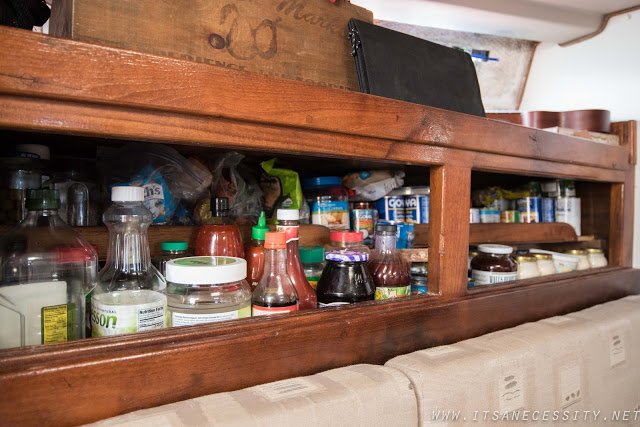 |
| Our biggest storage area, stand up bottles up front, milk packs laying down behind that. Kids’ snacks on top shelf. |
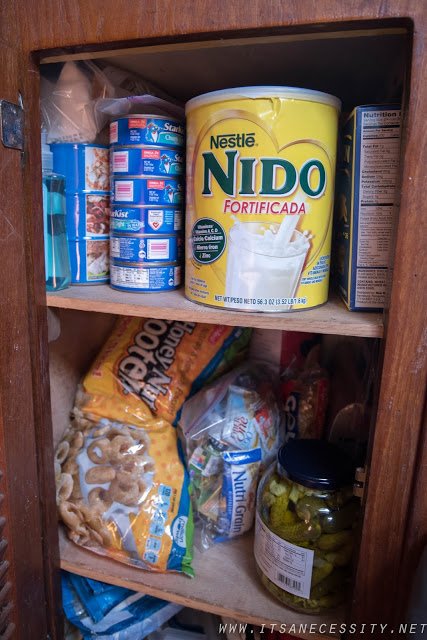 |
| Cereals, powdered milk, canned tuna, canned chicken, noodles, and TVP |
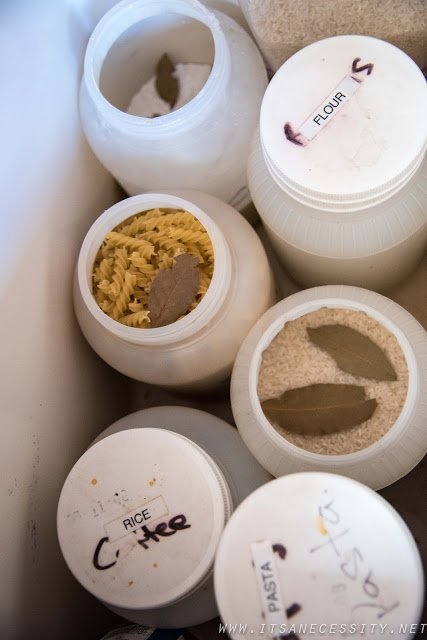 |
| Dried goods in drop down storage space. Rice, Flour, Pasta, and cereals. |
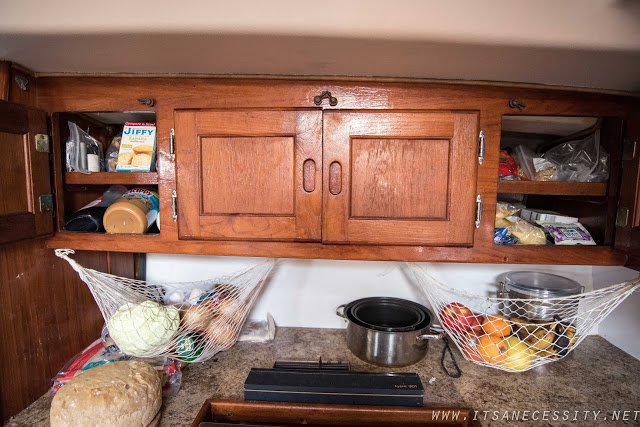 |
| Regular kitchen use stuff, with fruit and veggies hanging, and home made bread |

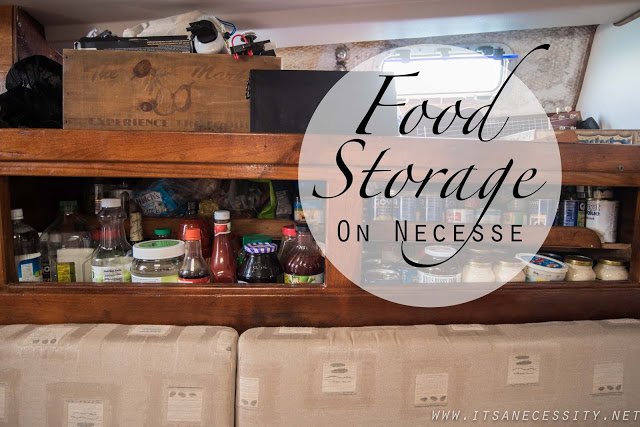
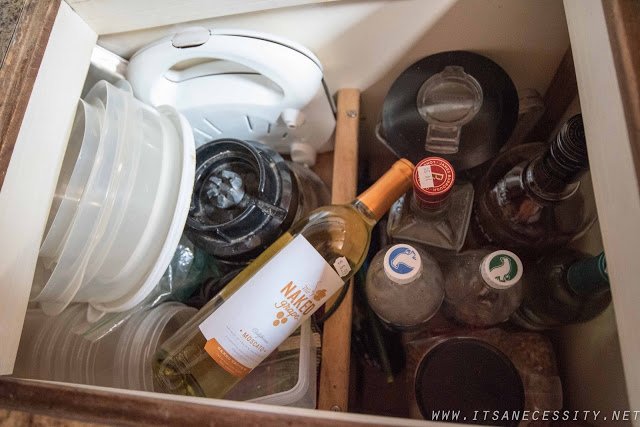

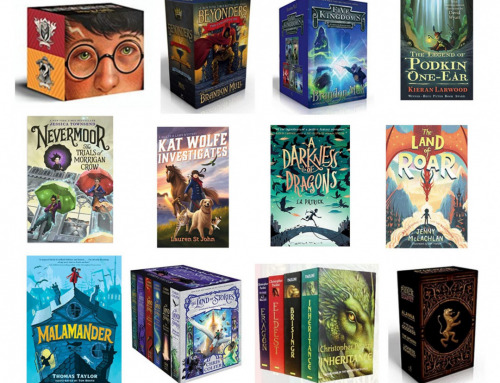

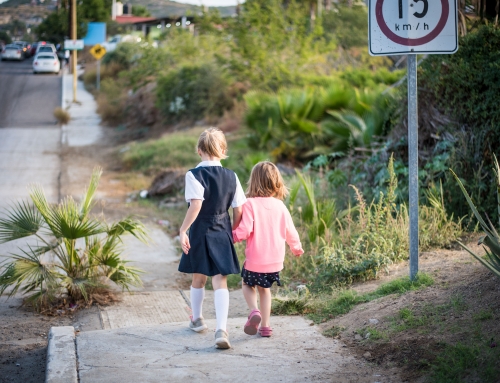

Do the Bay Leaves actually help with the weevils?
We haven't seen any since we have added the bay leaves, so either we just bought good batches of food or they are working.
Ahh I was wondering what those were! Good to know! We become liveaboards in 3.5 weeks, so trying to get as many tips as possible! Great post!
Ah, another user of NIDA. That and an Easiyo thermos make a great yogurt using no electricity. I learned the hard way Carnation instant simply WILL NOT WORK!
Yeah I did my research first and read several people saying use ONLY Nido, so that's what we do